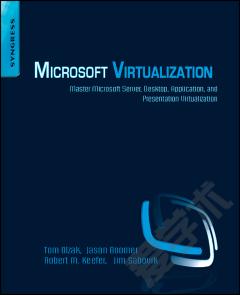Microsoft Virtualization —— Master Microsoft Server, Desktop, Application, and Presentation Virtualization
----- 微软虚拟化
Virtualization technologies help IT organizations in three ways: cost-cutting, ease of administration, and the overall effect of IT on the environment. Virtualization cuts costs by reducing the amount of capital resources (equipment), power, and cooling to run an IT infrastructure. Because of the tools that are involved in virtualization, it also reduces the burden of IT management significantly. Finally, by reducing the amount of cooling, power, and other emissions from these servers, virtualization can help IT organizations become more "green." Microsoft growth is up from 2006, when it held an 8% market share to 23%. When this report was released, Hyper-V had just started shipping, and is expected to make substantial market gain for Microsoft. A poor economy will actually help the growth of virtualization. Virtualization will gain IT dollars at the expense of other technologies for one reason: cost. Technologies that require high up-front expenditures but take time to generate ROI will be put on hold, while technologies like virtualization that promise immediate cost savings will enjoy broader adoption. Currenty, only 7% to 8% of servers are virtualized (worldwide) with many IT executives researching or planning to implement in the next 18 to 24 months. Covers Microsoft virtualization products completely, including Hyper-V Includes a special section on securing virtual infrastructure Gives hands-on instructions to help understand and implement Microsoft solutions Table of Contents Chapter 1: Introduction to Virtualization Chapter 2: Understanding Microsoft Virtualization Strategies Chapter 3: Installing Windows 2008 Server Core and Hyper-V Chapter 4: Managing Hyper-V Chapter 5: Installing and Configuring Virtual Machine Manager 2008 Chapter 6: Hyper-V and High Availability Chapter 7: Creating Virtual Machines and Templates Chapter 8: Performing Physical to Virtual and Virtual to Virtual Migrations Chapter 9: Monitoring and Managing a Virtual Infrastructure Chapter 10: Creating a Dynamic Datacenter with Microsoft System Center Chapter 11: Application Virtualization (Softgrid) Chapter 12: Deploying Softgrid Packages Chapter 13: Presentation Virtualization (Terminal Services) Chapter 14: Integrating Application and Presentation Virtualization Chapter 15: Desktop Virtualization Appendix A: Migrating Virtual Machines from Virtual Server 2005
{{comment.content}}








 京公网安备 11010802027623号
京公网安备 11010802027623号